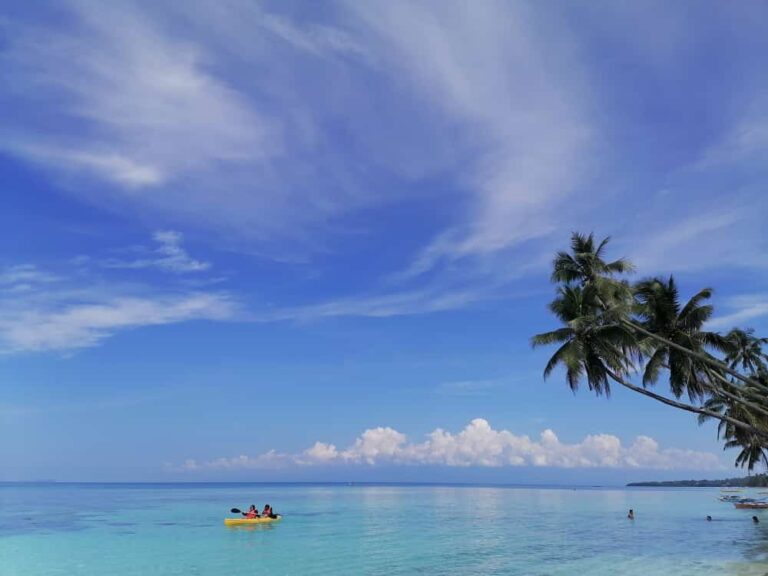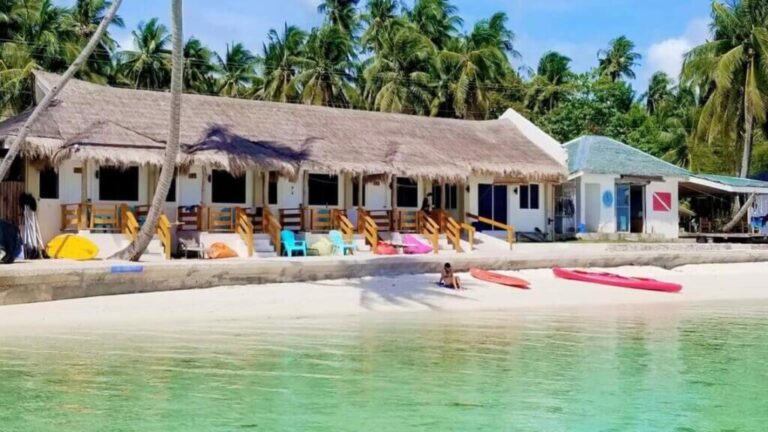
Scuba Diving Siquijor? Read This First!
Shrouded in mysticism and renowned for magic, Siquijor is a small island in the Philippines’s Visayas region, located south of Cebu and Bohol.
With a reputation for spiritual healers and pristine nature; Siquijor is one of the more off-the-beaten-track Philippines dive destinations!
There are many adventure activities here: waterfalls, caves, mystical healing, cliff jumping, viewpoints, skydiving, old churches and even older trees…
And of course, Siquijor is also an incredible place to scuba dive – it has some of the best coral reef in all of the the Philippines; home to turtles, macro critters and reef fish!
In March 2023, I finally went to Siquijor; something I’d been wanting to do since first hearing about this mystical island seven years ago.
Read on and I’ll tell you all about My Experience as well as stuff like What Makes Diving Siquijor Special and the Where to Stay for Divers.
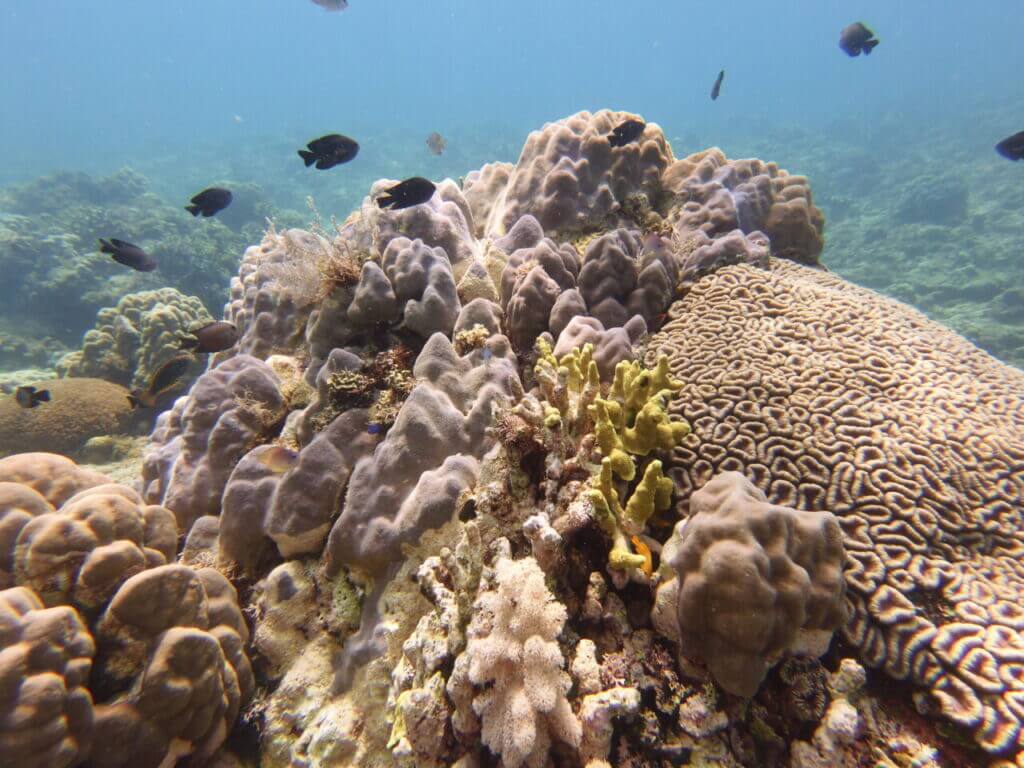
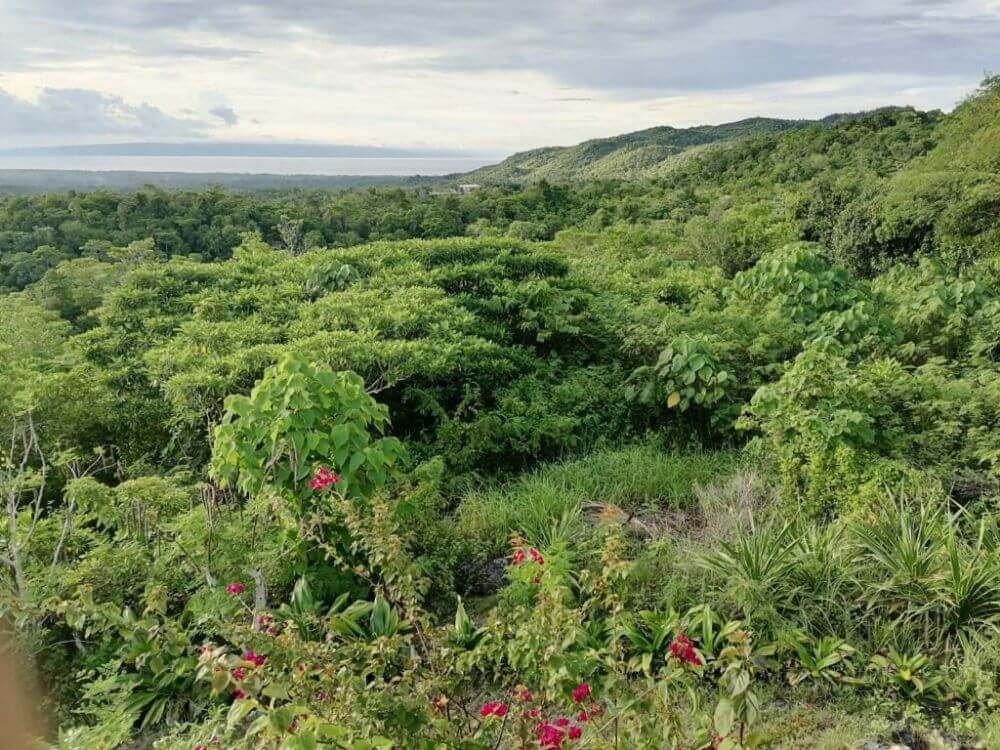
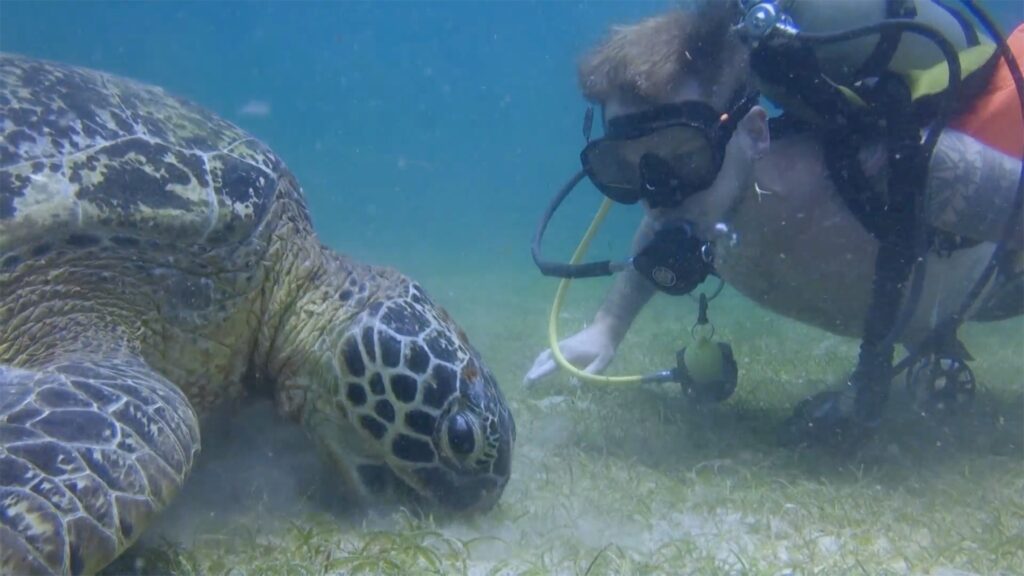
^ See that guy having a long debate with the Green Sea Turtle about the taste of sea grass? That’s me! (Alex, Creator of Diving Squad!). Currently, I’m living in the Philippines – specifically Panglao!. If you’d like to go for a dive together, grab a beer or just shoot the shit about Philippines diving, holla me on Whatsapp: +447812648968
What makes Diving Siquijor Special?
#1 Superb Coral Reef
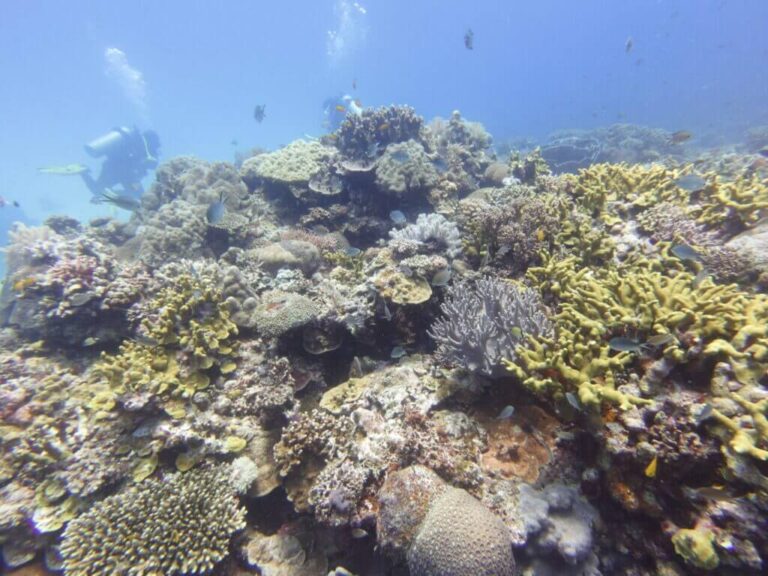
In 2021, the Philippines was bombarded by a series of severe typhoons which sadly took out much of the hard coral around a number of islands – however due to Siquijor’s sheltered location, most of the reefs there were unaffected.
As of today, Siquijor has some of the best coral reef in all of the Philippines with vast, sprawling hard and soft coral reefs in both shallow and deep waters.
These healthy corals present a vibrant living rainbow of colour to divers; like something out of an LSD-induced dream after watching Avatar and are home to many colourful reef fish, critters and turtles. Nice!
#2 Macro Critters
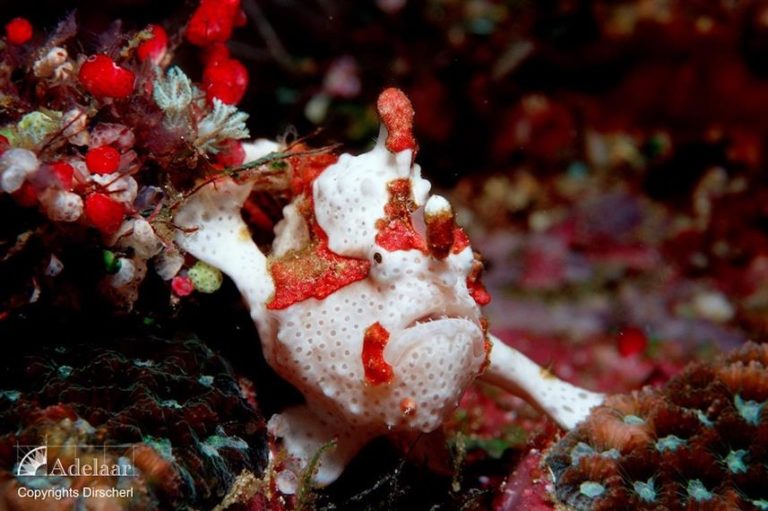
Siquijor is an especially great place in the Philippines to see macro (tiny) critters. There is a huge variety of small hairy crabs and shrimp as well as tiny nudibranch and frogfish that can be found hiding among the coral, crawling along the sand or even living on larger creatures such as sea cucumbers.
The dive guides at Sea Pearl were very talented at spotting macro creatures and pointing them out to us. When looking for macro critters yourself, some good places to keep an eye out for them: whip coral for tiny white shrimp, the sand for pygmy frogfish and tiny nudibranch among the nooks and crevices of coral for tiny crabs and bigger nudis.
#3 Huge Variety of Nudibranch
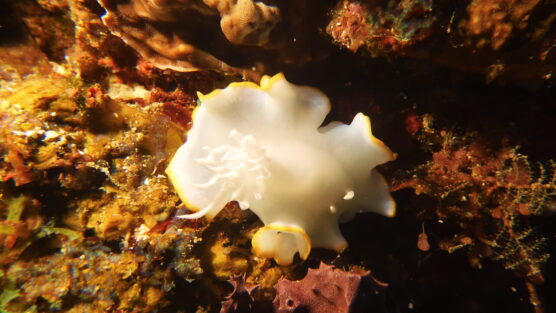
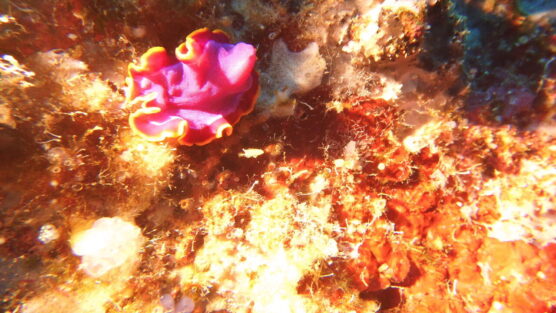
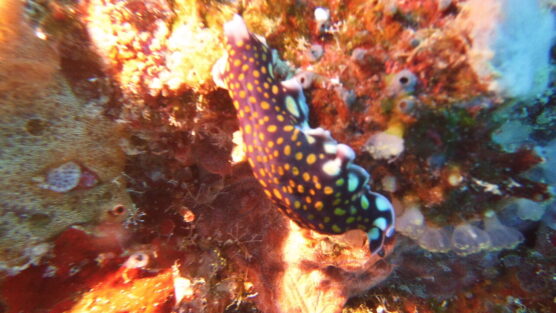
I dived Siquijor just 7 times but I’ve never seen so many different types of nudibranch as I did there – they came in all shapes, sizes and colours from tiny to large, flat to round and everything in between. (
Ok, so there weren’t any cube shaped nudibranch but that’s because they don’t exist.). All the same, I recall seeing at least 11 different species of nudibranch there!
#4 Turtles
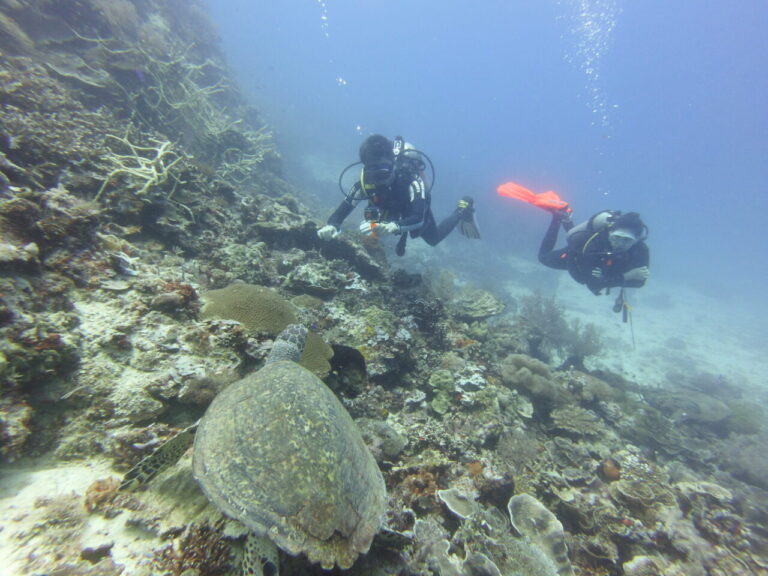
“Grab a shell dude”! Even before that immortal line from the otherwise highly overrated Finding Nemo came out, turtles have inspired people around the world for the beautiful appearance and calm, stoner-like mannerisms.
Like much of the Philippines, Siquijor is a great place to see turtles – especially green sea turtles but also sometimes the rarer hawksbill turtle species. You’re pretty likely to see at least one on every dive!
#5 Milkfish
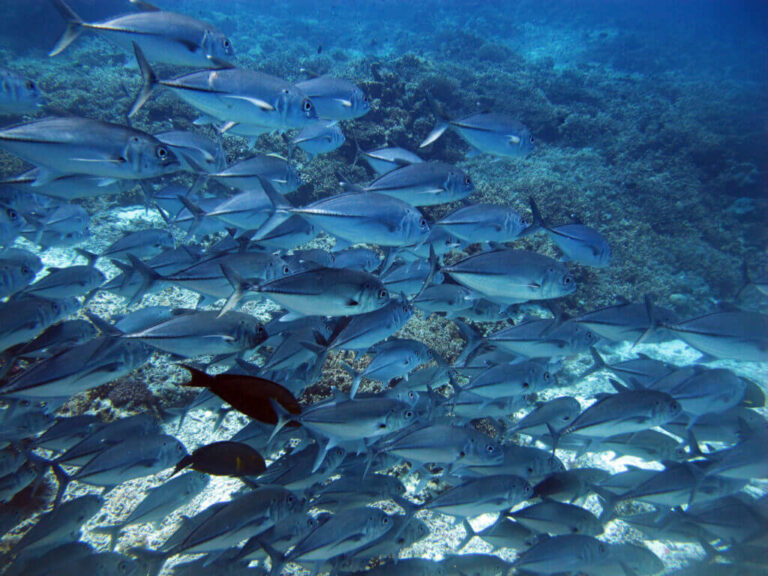
Known locally as Bangus aka Milkfish (the Philippine’s national fish no-less) are the sole living species of the family Chanidae. Other species of this ancient lineage died out around the late Cretaceous period so milkfish are true survivors!
Growing up to 5ft 11inches (1.8 m) long, they can be found in large schools around the dive site “Sunken Island”, an exciting drift dive for more experienced divers.
These are very cool looking fish; they’re a delicacy around the Philippines but are very rarely seen on dives. Of all the many places I’ve dived the Philippines, Siquijor was the only place I saw them underwater.
#6 And More!
There’s a great many other marine species that divers can see around Siquijor including sea snakes (banded sea krait) barracudas and sometimes even whitetip reef sharks around the dive sites known as “The Cave”.
Where to Stay in Siquijor for Divers
Siquijor may be described as a “small island” but it’s still pretty big, taking 3 hours to drive around.
With this in mind, it’s extremely important to note that virtually all of the dive resorts and centres (as well as hostels and restaurants) are actually located within one small area; San Juan on the west side of the island; which is also near to all of the major dive sites.
Therefore it’s essential you stay nearby! I actually made the mistake of residing 15km away and it was a real ball-ache getting back and forth between the dive centre and restaurants every day!
I wrote an entire separate article reviewing the 10 Best Places to Stay in Siquijor for Divers which you can Read Here.
That said, if you haven’t got time to read all that, the 3 of the Best Places to Stay in Siquijor for Divers are:
- CoCo Grove Beach (Most Luxurious)
- Tropical Fun Ta Sea Rentals (Mid-Priced & Popular with Solo Travellers)
- Lazy Lizard (Best Cheap Hostel)
Best Siquijor Dive Sites
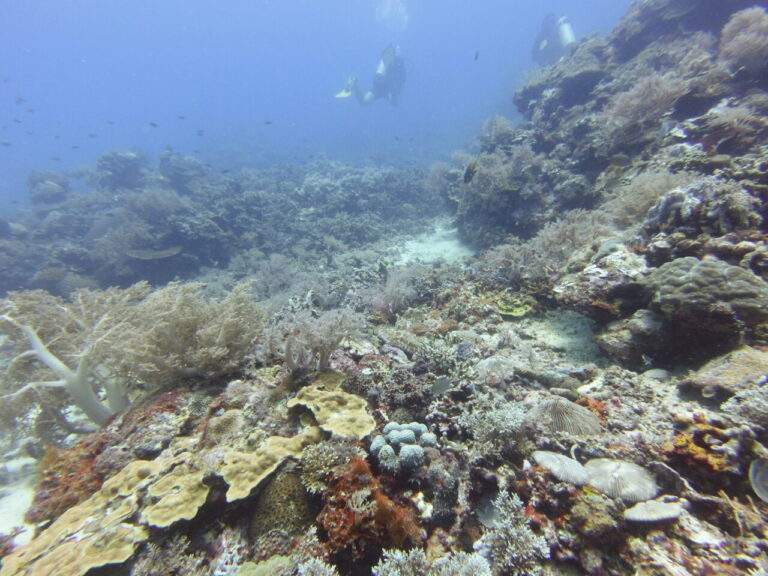
There’s around 20 dive sites at Siquijor but there are some especially popular exceptions:
- “The Wall” is an all-time favourite; it is a long stretch of reef that reaches down to over thirty meters and is a great place for spotting large frogfish and many reef fish.
- “The Cave” lies a little further onwards from the wall and is a seldom dived cavern filled with colourful soft corals and sponges. In the early morning, lucky divers can sometimes see whitetip reef sharks here.
- “Sunken Island” lies 2km out to sea and is a rising plateau of extensive hard coral which is not sinking but actually slowly rising upwards; it will be visible above the sea by around the year 2120! Unlike other Siquijor dive sites; this is a pretty strong drift dive so best suited for experienced divers. As well as colourful fish and turtles, you can see schooling milkfish!
- “Coral Gardens” are a series of shallow soft corals where you can find many macro critters including all manner of nudibranch and crustaceans. There’s often a lot of turtles around these shallower dive sites to.
Virtually all Siquijor dive sites take just five to ten minutes to reach by boat. Nighttime shore dives are also available when at least two divers want to go.
Choosing a Siquijor Dive Centre
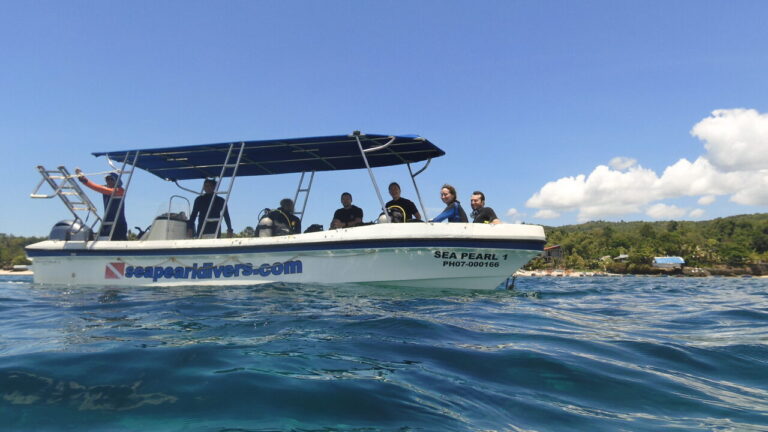
Most of the luxury resorts in Siquijor (and a few of the cheaper hostels) have their own in-house dive centre. However, if you stay somewhere without it’s own dive centre; there are many nearby public dive centres to choose from.
Whilst I was at Siquijor, I went with Sea Pearl Divers (located in San Juan) who offer low prices, experienced dive guides and excellent customer service.
I’d strongly recommend these guys; the dive guides were very attentive to guests and exceptional at spotting even the tiniest of critters. Rental gear was in great condition and the staff were a really friendly and hilarious bunch! I even got invited to a party at one of the dive guides houses at the end of the week – it was bloody great fun!
Siquijor Diving Season
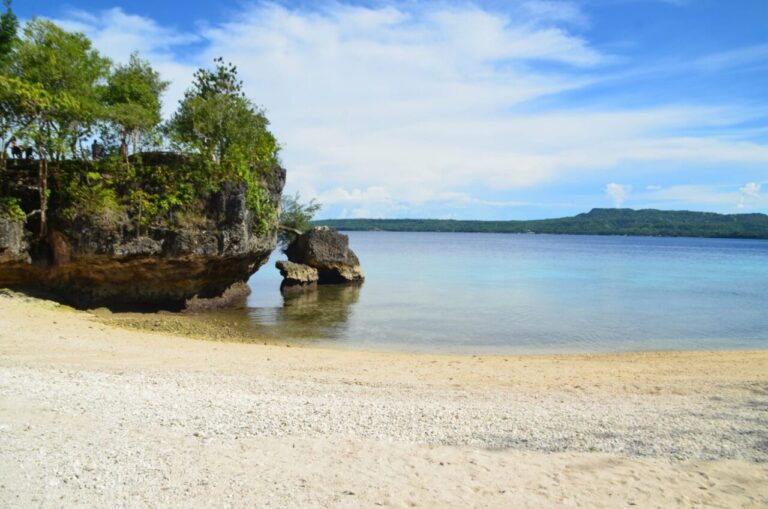
Awesome news! Siquijor can be dived year round! Even during rainy season, it experiences less rainfall compared to other parts of the Philippines. That said, here’s what you can generally expect the weather to be doing over the course of a year:
- December – April: This is dry season; during which time, rain is virtually non-existent and water visibility is at its all time greatest.
- May is a transition month from dry to rainy season and so tends to be a little unpredictable. Some years it’s dry, others it’s kinda wet!
- June – November: This is rainy season; however Siquijor doesn’t get as much rain as other parts of the Philippines, plus most dive sites are close to the shore meaning the water is virtually always calm (with the exception of the drift dive known as “Sunken Island”).
So, if you find yourself in the Philippines during rainy season, Siquijor is one of your all time best bets for calm diving conditions.
Other Things to Do in Siquijor
Despite Siquijor being a small, laid-back island there’s actually a helluva lot of extra activities to be had here, especially for adventurers and nature lovers! Let’s take a look at some of the most epic things you can do in Siquijor besides dive:
#1 Mount Bandilaan National Park Tower
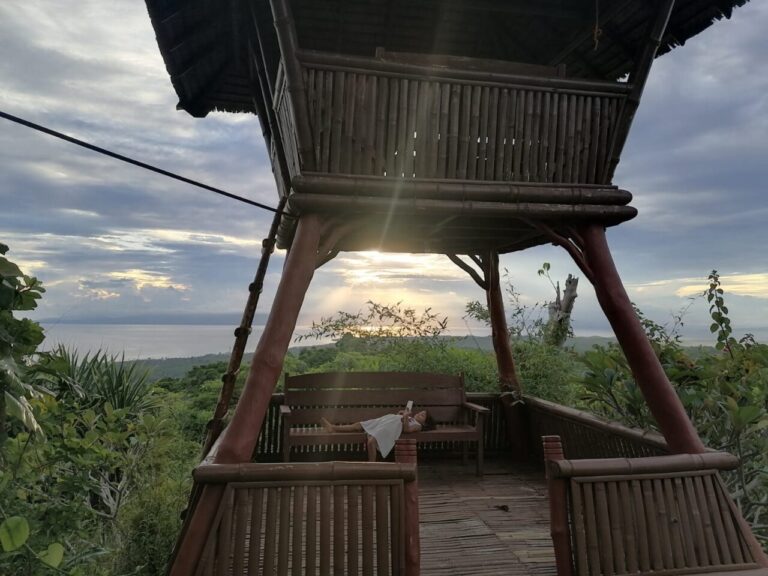
Located on the highest and most central part of Siquijor Island is Mt. Bandilaan Viewpoint Tower. It’s a scenic uphill scooter ride that takes some 45 minutes from most parts of the coast.
This is followed by a 300 meter climb up the tower steps to be rewarded with the most kickass of views – a 360 degree panoramic of the entirety of Siquijor.
It was only after getting up here that I realised that the vast majority of Siquijor is untouched jungle – it was a truly incredible sight to behold and I’m so glad I went!
A ten minute scooter ride away, there’s also the butterfly sanctuary which is a relaxing way to pass an extra five or ten minutes. Several of the local healers also live very close by…
#2 Mystical Healing
A number of shaman and healers reside on Siquijor. To get hooked up with one ask around and the locals can give you a number – I strongly suggest asking the staff at wherever you’re staying for this.
Alternatively, there is a sign to what I believe is one of the shamans houses close to the butterfly sanctuary (which is near Bandilaan Park Tower). I forget exactly what it says, I think it’s along the lines of “something healing something garden”….maybe.
By paying a small donation amount of your choice you can experience a variety of traditional healing ceremonies.
#3 Cantabon Cave
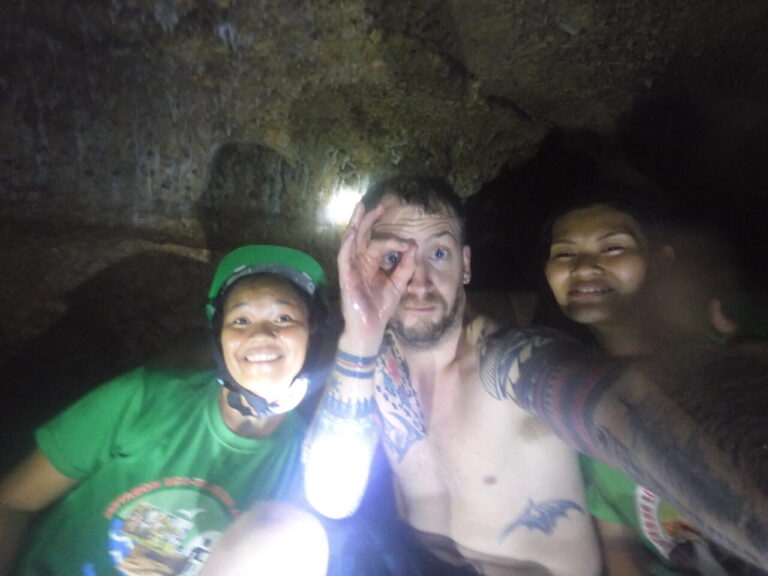
This is a lot of fun! It’s also located towards the upper, central zone of Siquijor. You have to pay for a guide, helmet and torch and then you can explore Cantabon Cave which goes 1km back. It takes about 90 minutes in total to explore. Bring clothes and shoes that you don’t mind getting wet!
There’s a lot of interesting rock formations as well as a small pool you can swim in. The going gets pretty tough in places – you want to have a decent level of fitness and stability to do it. That said, provided you do, it’s not too challenging! Definitely a worthy experience for those more adventurous of you souls!
#4 Waterfalls
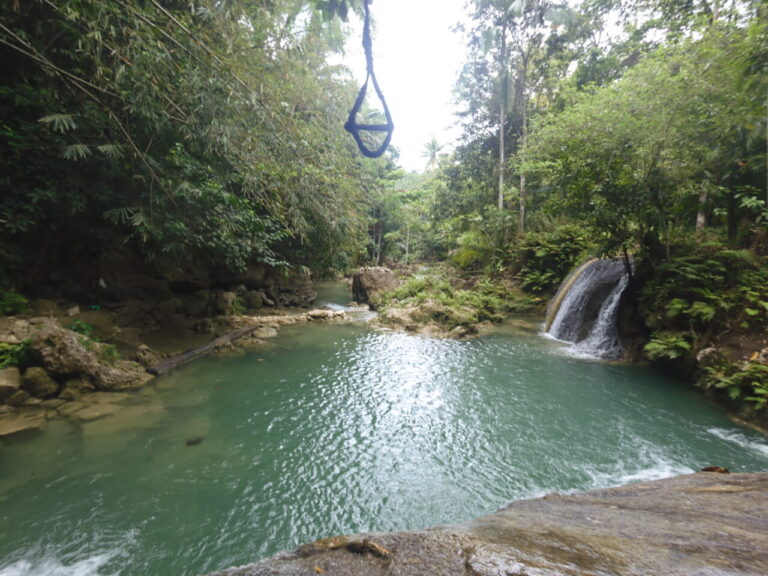
Siqiuijor is absolutely rammed with epic waterfalls. The best ones are:
- Cambugahay: The most popular (and busy) series of falls. There’s a couple of swing ropes you can go on as well as a floating wooden raft. Lots of people here, unless you go super early in the morning…
- Kinamandagan: More off the beaten track and with a much steeper descent / ascent. There’s another swing rope you can opt for as well as a small cave under the falls you can go into. Less people come here. Pretty close to Cambugahay.
- Lugnason: Another highly popular fall, some say one of the most beautiful in Siquijor. Located some distance away from Cambugahay and Kinamandagan, close to San Juan.
#5 Salagdoong Cliff Jump
Salagdoong beach is one of the most popular beaches on Siquijor (albeit on the other side to San Juan meaning it’s a bit of a mission to get there).
There are two jumping platforms that let you jump straight into the sea – one is 16 feet (5 meters) and the other is 32 feet (10 meters). You can only jump during high tide so make sure you go at the right time!
#6 Sky-Diving
Yes, you can go sky-diving over Siquijor for truly mind-blowing views of awesomeness and epic proportions. It is pretty expensive though. Check out the Siquijor Sky-Diving facebook page for more info!
#7 Old Balete Tree
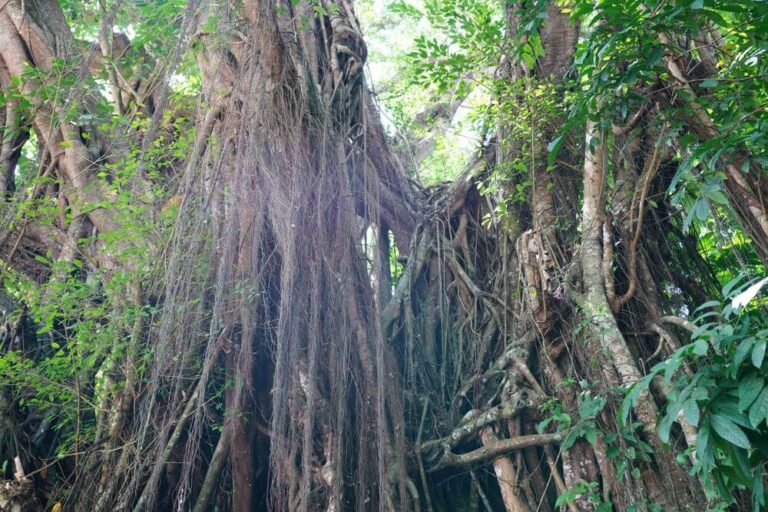
Balete trees (a type of fig tree found in the Philippines) are extremely long-lived parasitic trees that grows on other trees, strangling them until they die. In Filipino Folklore, Balete Trees are said to be home to otherworldly beings like dwende (basically elves), tikbalang (horsey demons) and diwata (faeries) and yet others, many stranger still.
The “Old Balete Tree” is the oldest one in Siquijor; being over 400 years old. Making this particular Balete Tree even more mythical is the fact that a natural spring flows, the source of which noone apparently knows, flows right under it and the other trees it’s growing on.
This cold water spring flows into a manmade pool filled with fish – many people come here for a free foot spa with the fish nibbling the dead skin of their feet! It does get extremely busy here – it’s free to go but nice to make a donation for the upkeep! Someone’s gotta clean out all that fish poop…
There is a parking lot right by the Balete tree so getting here via scooter or tricycle is super easy!
#8 Lazi Church
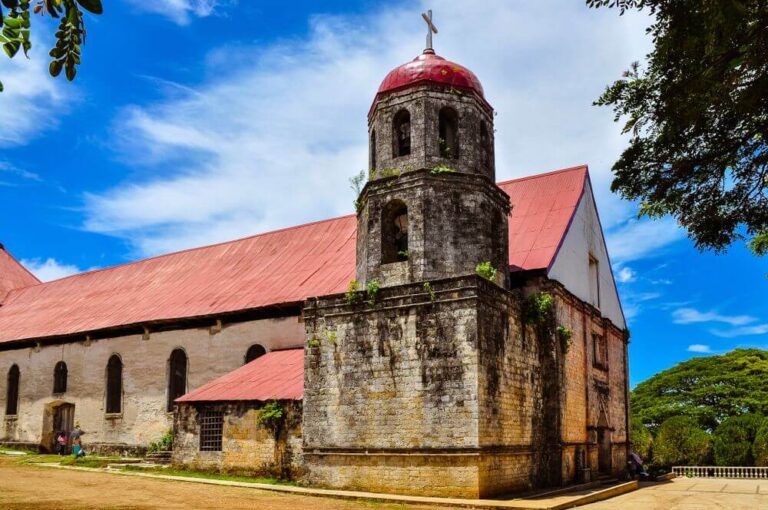
Lazi Church is a group of colonial style buildings – a church, bell tower and convent that were built between 1884 and 1891 by Filipino artisans using a combination of coral stone (eek) and hardwood. These are impressive looking buildings; I actually thought they were much older when I first saw them!
You can go inside the church and have a walk around or stroll around the outside grounds. It’s pretty chill! Lazi Church is located 21km from San Juan (the tourist hub = accommodation and dive centres) so takes about 30 minutes to reach from there. It’s close to Cambugahay falls!
How to Get to Siquijor
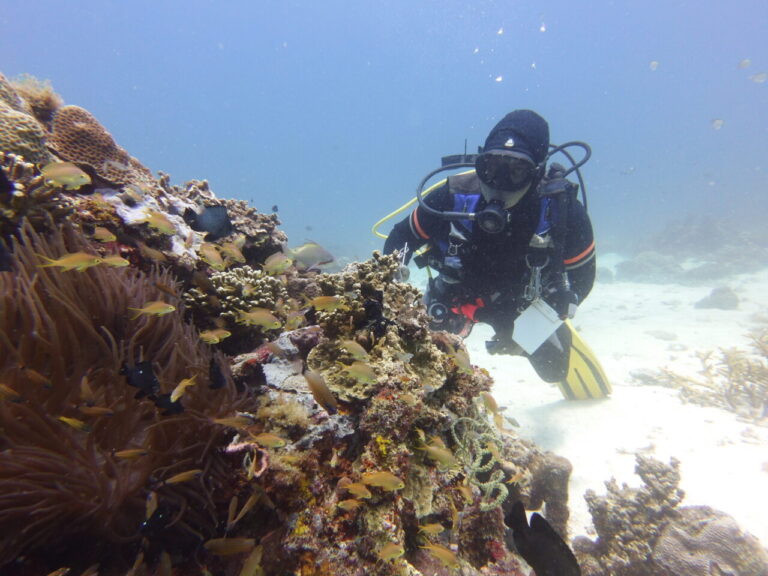
Siquijor is easy to reach and only takes a few hours via ferry from nearby locations such as Bohol and Dumaguete.
You can Check Ferry Schedules to Siquijor via 12goasia.
It is also possible to fly into Siquijor airport from Cebu Mactan but this is a lot more expensive than catching the ferry!
Grand Admirals Log: My Experience Diving & Exploring Siquijor
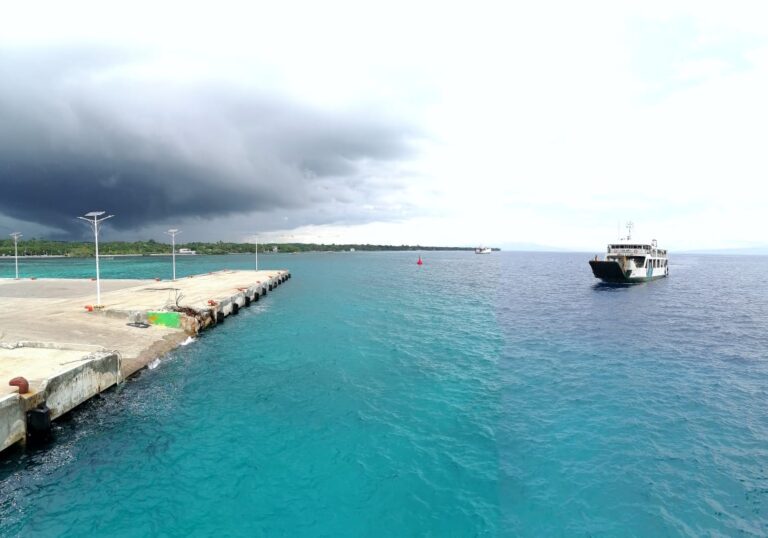
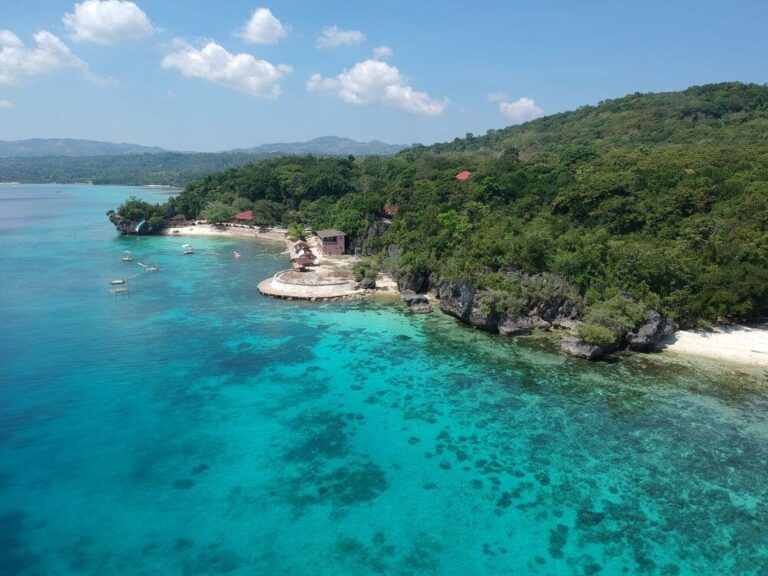
It was the dawn of April 2023 as I stood at the bow of the boat, one knee raised to rest my boot on the rails, hands placed firmly on outwards thrust hips and swinging my arm forwards in a dramatic point towards the mysterious looking island growing closer by the second. “Onwards – to Siquijor and glory”! I roared.
After being told that the helmsman already knew where to go; I sprung down from the bow and swaggered alongside the ferry’s rail; reaching the stern before spinning around to glance once more up at Siquijor; growing ever closer.
It may look a small island on the map; often not included at all and when it is as little more than a full-stop in the south Philippine’s Visayas region, beneath the tips of the much bigger islands Negros, Cebu and Bohol and above the huge Mindanao island.
But having a surface area of 343.5 km squared, Siquijor is still big enough to be an entire world unto itself once you get there; with much to explore including reefs, caves, waterfalls, cliffs, forest and perhaps most famous of all – ritualistic magic.
Siquijor certainly now did seem like a world as it loomed above us; a jumbled mishmash of jungle coated hills and ridges separated by plateaus of rice paddies and fringed by a crown of white sand beaches that disappeared around the now distant seeming sides of the island.
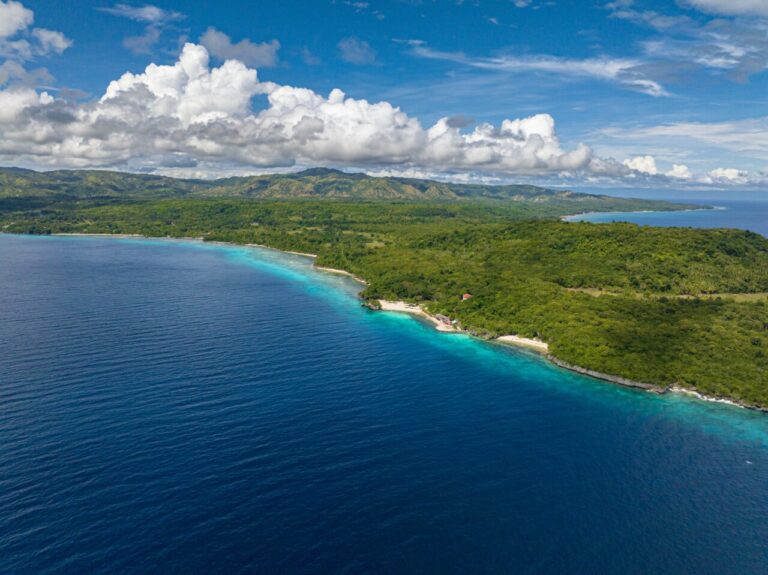
In earlier times, many believed that the nature of the magic on Siquijor was dark. Indeed when I’d first ever heard of the place, it had been on a somewhat poorly informed travel article describing it as a place of “witches and black magic”.
This did indeed spark my interest, I considered paying a dark witch to create ten curses and place each one of them in a cardboard box; the idea being to then sell these authentic curses overseas – at maximum price to the highest bidder.
However, having since researched the island more, I already knew that the nature of the magic was more of healing and positivity. Although these generally turn less of a profit compared to darkness and despair; it still sounded cool and so this; as well Siquijor being hailed as an epic scuba diving and outdoor adventure destination; had compelled me to go.
The setting sun was already bleeding the sky red as I disembarked at the untidy little cement port and grabbed a tricycle to where I was staying. We quickly passed through San Juan; Siquijor’s capital; barely more than a little seaside town but still the central tourist hub where one could find various dive centers, tour agencies, hostels, bars, resorts and restaurants.
We passed through it all on the tricycle in just five minutes and then continued; the sides of the road once more reclaimed by lush vegetation, along the narrow little pot-hole riddled main road ringing the entire island. In fact we continued to drive for quite a good deal longer than I’d expected.
Past little villages of tin roof houses where scrappy dogs and children played outside up a hill, until I found myself 15km out of town or literally anything whatsoever. We’d arrived at Winyanz Tambayan Tourist Inn; a charming little resort upon a small cliff overlooking the ocean.
It was a beautiful place to stay; although not ideal for divers as it was so far from all the dive centers (check out my main page on where to stay in Siquijor for divers to know where you should stay!).
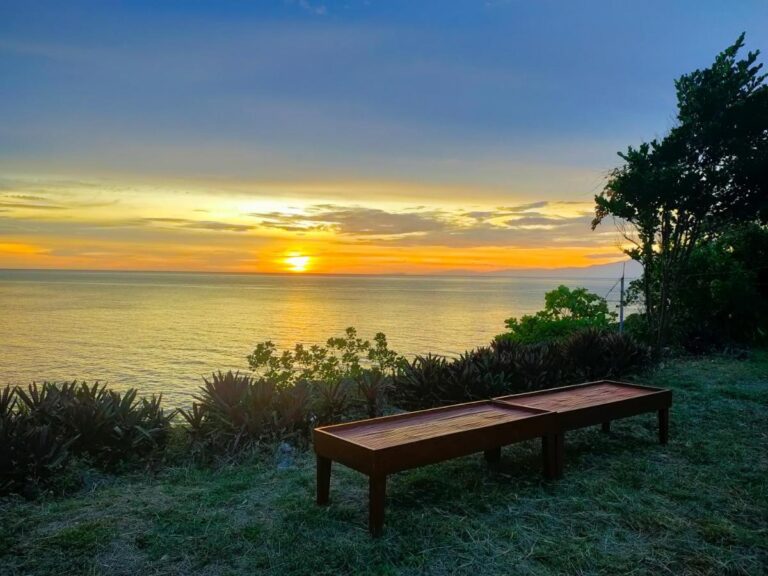
The next day, I rode a scooter back to San Juan (Siquijor’s tourist-hub) and visited Sea Pearl Divers, whom I’d already heard good things about in Bohol. It was a smallish dive center and whilst it didn’t have any accommodation; it was much cheaper than the Siquijor Dive Resorts that do.
I immediately liked the vibe of Sea Pearl Divers; the staff were most funny and very helpful: within no time at all I had signed up to dive the next day. Huzzah!
And dive the next day I did – we spent the morning’s dives diving those dive sites of various shallow water coral gardens, close to the golden shoreline, it was shallow here – no more than ten meters deep. All manner of beautiful hard and soft corals were to be seen; it was some of the best reefs I’ve witnessed in all of the Philippines.
The 2021 Philippines typhoons damaged much reef around other parts of the archipelago – however, the corals of Siquijor were left relatively unscathed.
This was largely due to Siquijor islands sheltered location, being protected from the north by the much larger islands of Bohol, Cebu and Negros and also sheltered to the south by Mindanao; the second largest island in all the Philippines.
Hiding within and among the coral were many macro critters: tiny frogfish, nudibranch, hairy crabs, shrimp – and whether I could name them or not; they were fascinating to observe; coming in all shapes and colours and ranging in size from small to tiny.
Each was a unique and quirky critter little thing; they all had their own mannerisms and ways of moving; it was like beholding some micro alien world.
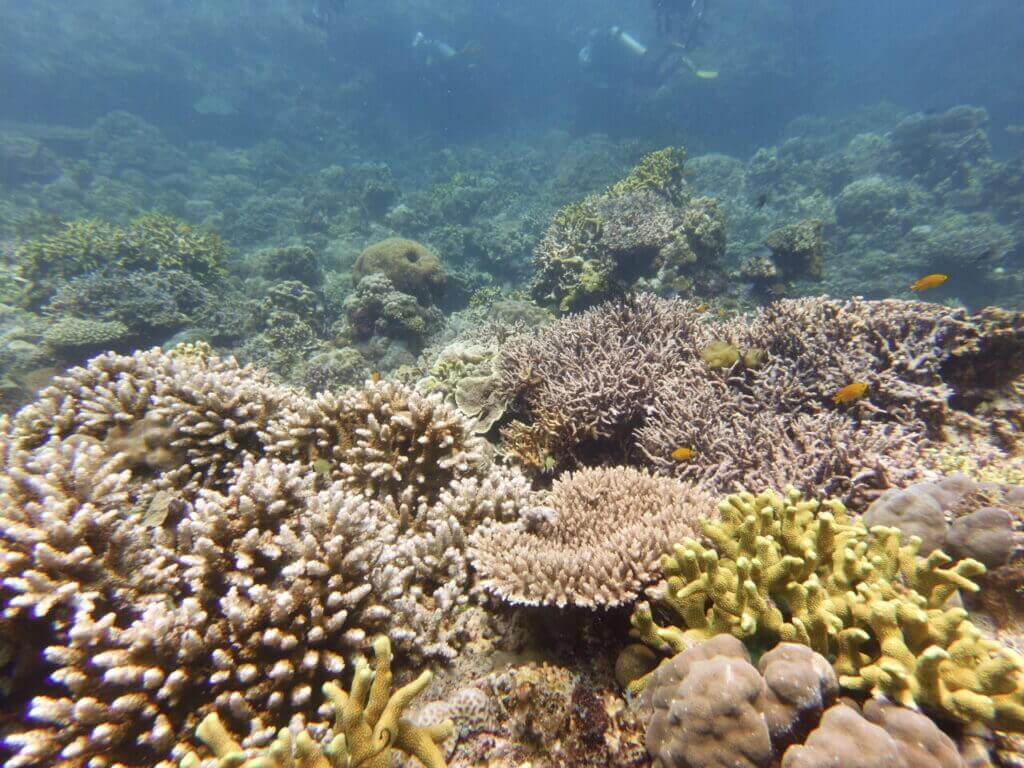
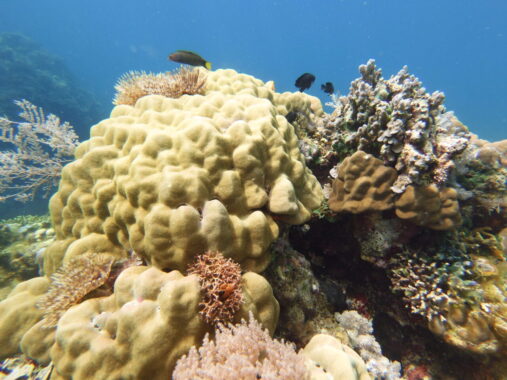
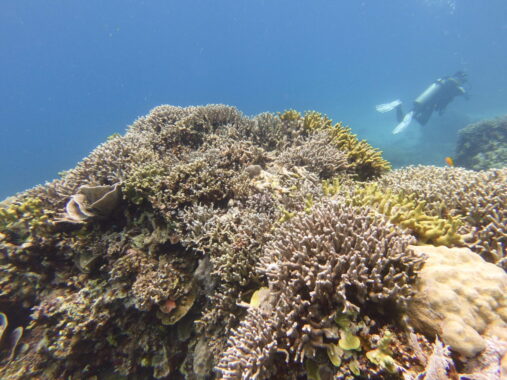
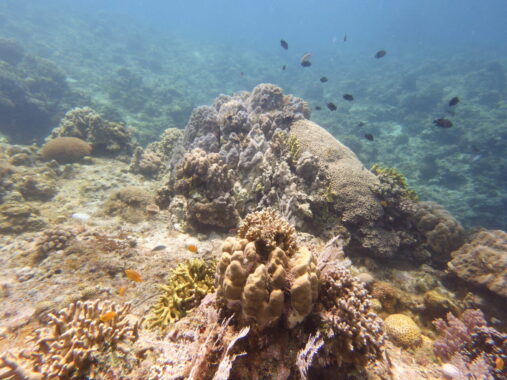
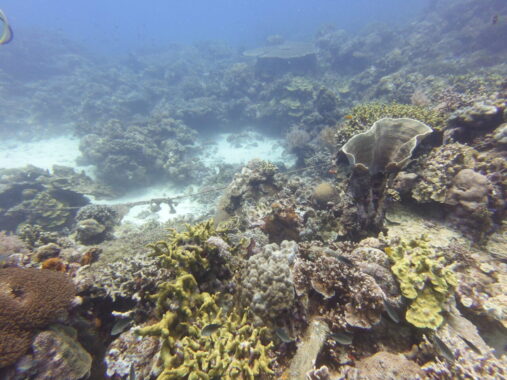
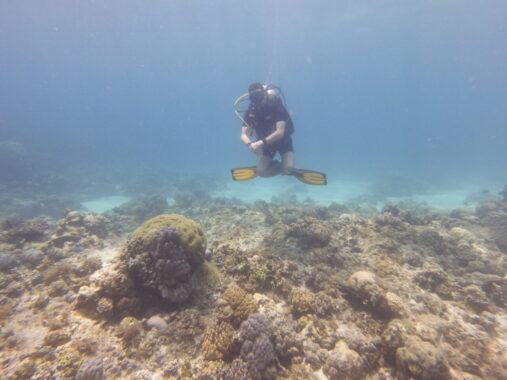

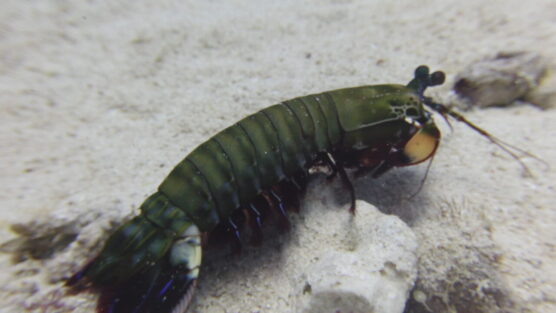
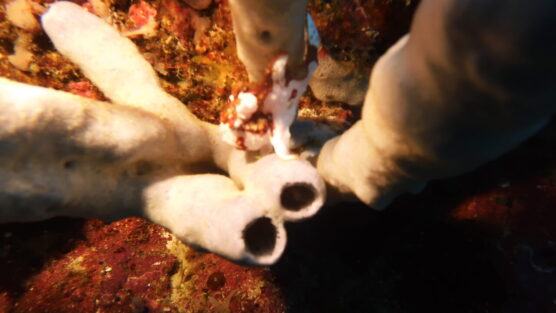

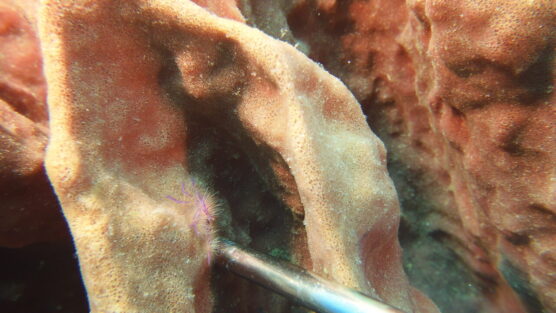

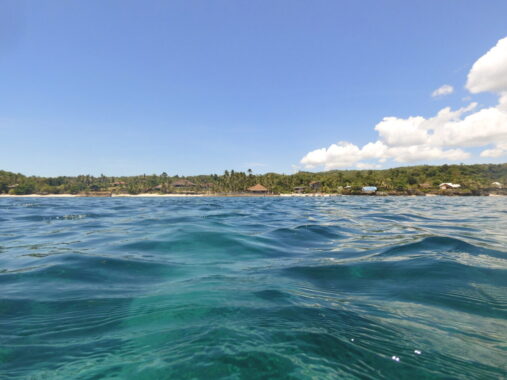
That afternoon, I headed inland towards the heart of Siquijor. I rode away from the beaches and up a road that at first started as a gentle slope and eventually rose into a twisting uphill drive.
Soon I found myself up in the highlands of Siquijor where jagged jungle jaundiced hills cut zig zag outlines into the sky like miniature mountain ranges and tiny villages and clusters of scrap metal houses occasionally lined the road.
Filipino children stared at me as if I was the first white devil they’d ever seen, which definitely was not the case but there were certainly admittedly less of us up here. I was now at the top of Mount Bandilaan; the highest peak of Siquijor at 557 meters above sea level and before me lay what I had come for: the observation tower.

Noone else was about as I climbed up the steps in the sweltering heat. When I reached the top, I was met with a spectacular sight.
I could see all the way to Siquijor island’s coastline in every direction for three hundred and sixty degrees. It was amazing to behold how the vast majority of the island was still covered in jungle; the twisting trunks of tree tops turning and writhing around one another in a dense cluster of lushness for as far as the eye could see.
A pair of tropical birds chirped and trilled around the tire as they dived and looped circles around one another – fighting or fu*king I suppose.
If I strained my eyes I could actually make out the white tops of waves crashing against the small rocky cliffs and islets dotted around Siquijor’s coastline some ten miles away or the occasional boat cutting through the waters on its way around the island.
Depending on which way I gazed off into the distant horizon; I could see much larger Filipino islands: the distant jagged cliffs and volcanos of Negros, the stretching plateaus rolling up into hilly highlands of Bohol and Cebu; the snaking rocky peninsular of Mindanao’s northern Zamboanga peninsular.
Each place, a whole world within itself yet connected and reachable to all others in this mighty archipelago, simultaneously separated and connected by the tropical turquoise waters surrounding it. Gods, I love the Philippines.
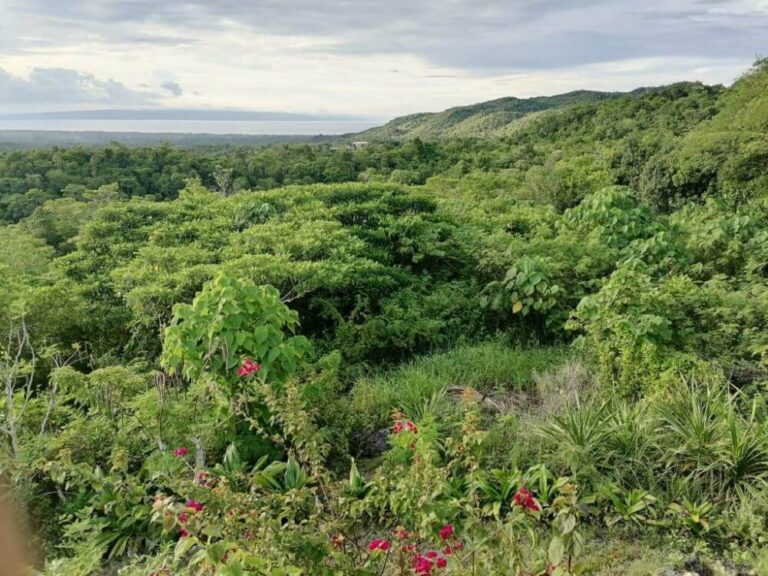
The next day, with Sea Pearl Divers, I dived another one of Siquijor’s best dive sites: “The Wall”. As I said, the coral reef of Siquijor was next level (even by Philippines standards), so being able to observe it in deeper waters (down to 30 meters) where there were more species of hard coral was awesome.
There were a couple of very big frogfish camouflage seamlessly against the corals – one orange, the other black. As well as this I saw countless schools of pelagic fish swimming past in the open waters to my left – sardines, jacks and barracuda as well as all manner of smaller and more colourful reef fish to my left skirting in and out of the coral cracks and crevices.
Our next dive site from here was called “The Cave”; it was an impressive open cavern filled with all manner of sponges and soft corals across which crawled and slithered armies of thousands of white wormy things, probably some type of sea cucumber. I later learned that this is a good dive site for seeing whitetip reef sharks in the morning but I didn’t see any.
As we made our way back out of the cavern though I did spot a big old green sea turtle cruising past in a most turtle like manner.
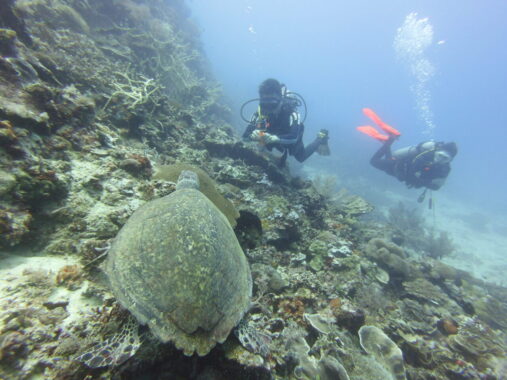
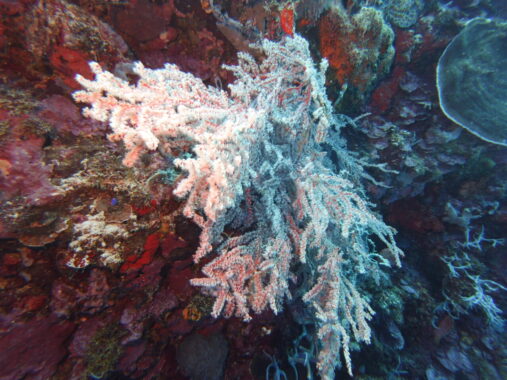
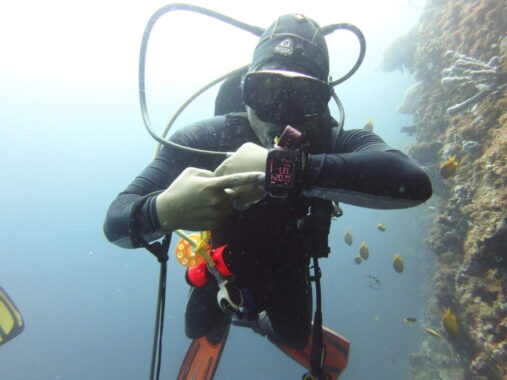
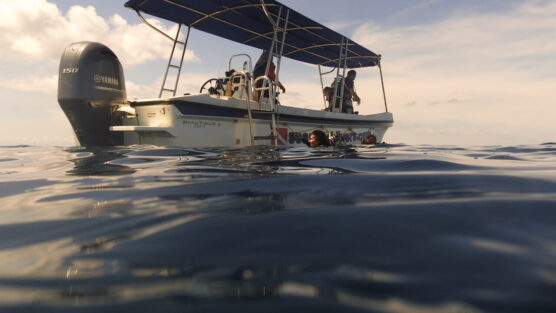

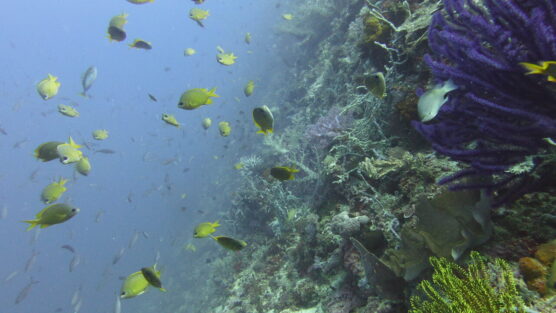
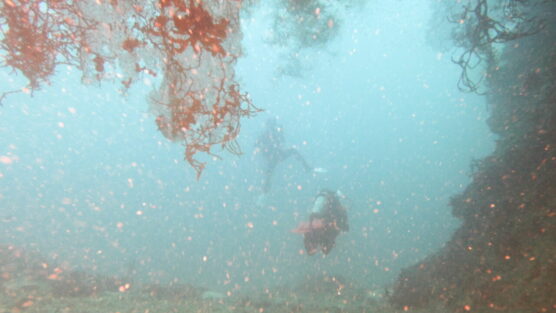
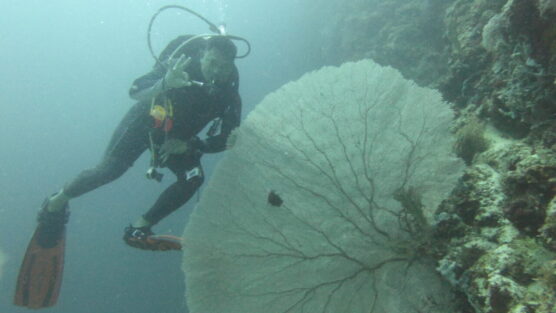
That afternoon I jumped onto my mighty metal steed (scooter) and went tearing off across the island again – first I went blasting from waterfall to waterfall – first Cambugahay; the most busy of all Siquijor’s falls: here there were many peoples so I only stayed long enough to swing from some rope-swings before riding on to the much quieter Kindamandagan waterfall; this one had a far steeper descent and there was noone else around.
I spent longer here; there was another swing jump but also a tiny cave under the base of the tumbling waters which I dipped down under and spent a little while in; watching the carpet of tumbling waters shutting the rest of the world off from me as they trickled down the jagged mottled rocks above and around.
There were just a few hours of daylight afterwards – still long enough to get to Cantabon Cave where two local Filipinas guided me through 1km of ever tightening underground tunnel; across tight ledges of jagged slippery stone, through icy pools of water and before various rocks that apparently resembled things such as turtles and heads according to them but just look like rocks to me.
It was a nice little cave; somewhat bigger and more challenging than many I’ve been to but not as mighty as others. I returned to my room that night rather tired; I had just enough time to grab an icy beer from the restaurant, chug it down and pass out on the bed.
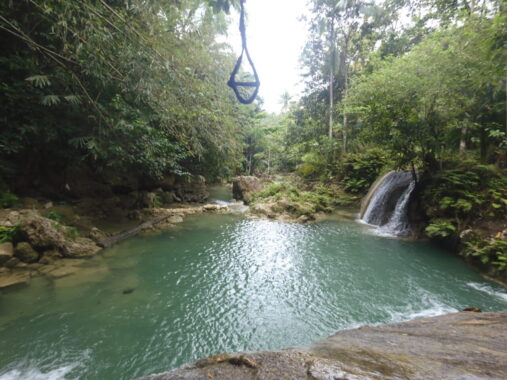
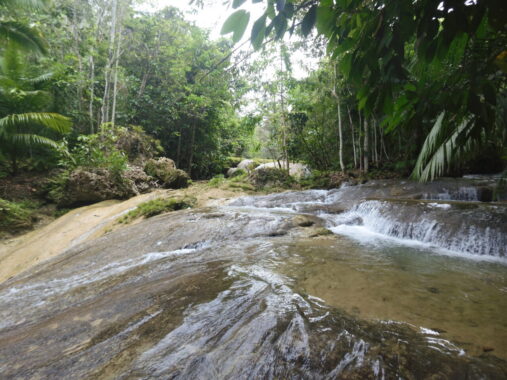
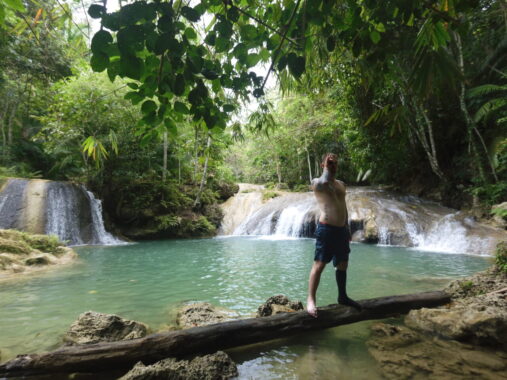
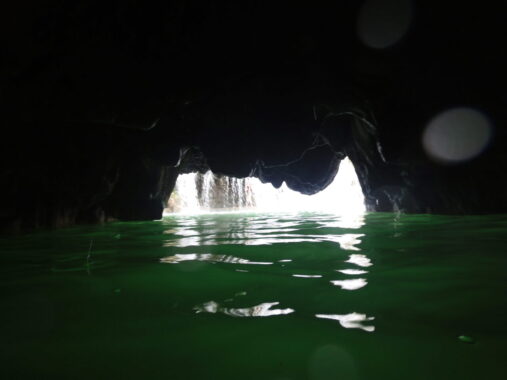
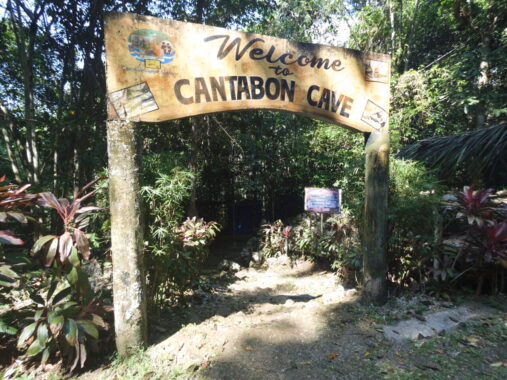
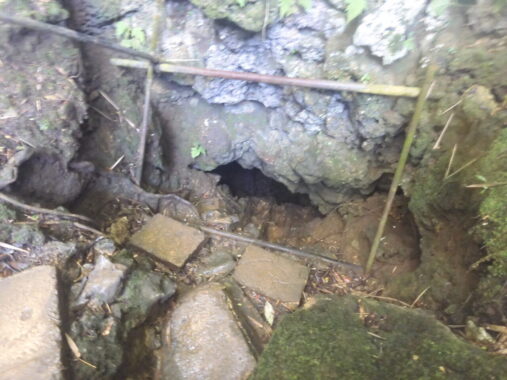
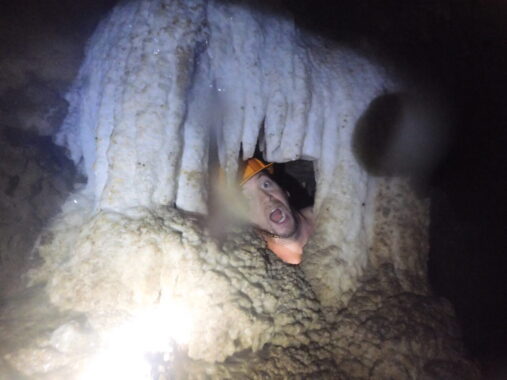
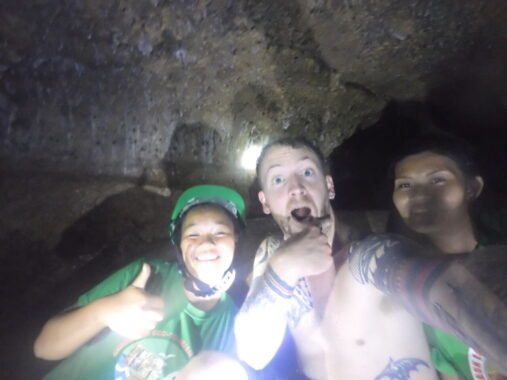
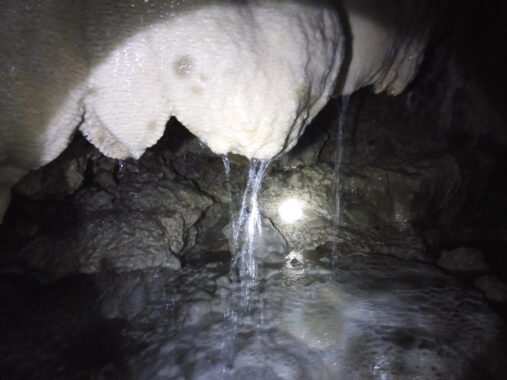
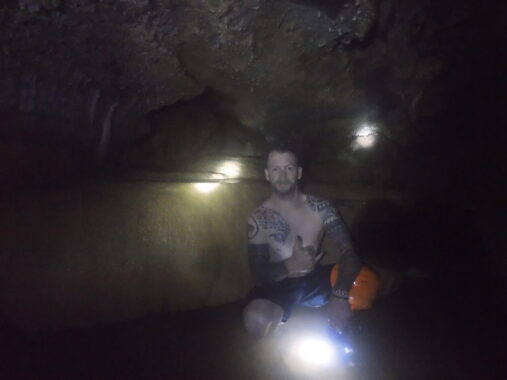
The next day I visited the Old Balete Tree – a four hundred year old, parasitic species of Filipino fig tree that grows on other trees, strangling them to death. They are said by many to host otherworldly beings like dwende (basically elves), tikbalang (horsey demons) and diwata (pretty much faeries) .
Making this particular Balete Tree even more mythical was the fact that a natural spring flowed right beneath it – and noone knows where it comes from… dun, dun, dun!! From here, the cold water spring flowed into a manmade pool filled with many big ol’ fish – which crowds of people were there to get a free foot spa from, the fish nibbling away at their toes.

Next I headed for Lazi Church: complete with bell tower and convent it was a group of colonial style buildings that had been constructed between 1884 – 1891 by Filipino artisas using coral rock (oof…) and hardwood. They were impressive buildings; indeed I thought they were actually much older when I first saw them.

Next day I done dove again and we made our way 2km out to sea to Sunken Island; a plateau of hard coral which despite its name is actually rising out of the ocean so that it will break the surface in the next hundred years – so Rising Island would be a more accurate name!
The coral here was indeed very impressive and varied; virtually all of it was hard coral and in excellent condition as we slowly explored it against a current that grew in strength until the fish started to blow past us and people raced through their air.
Right at the end of the dive, a mighty school of milkfish (aka bangas) appeared out of nowhere. Not only are milkfish the national fish of the Philippines, they’re also the sole living species of the Chanidae fish family; the rest of which went extinct around the Cretaceous period, making milkfish ancient survivors.
They were powerful yet streamlined looking fish; rather prehistoric in appearance with silvery bodies of muscle and sharp scales; a few of the biggest individuals must have been five foot long.
There were countless hundreds of them – they all went streaming past very fast indeed; for a moment the water’s around us seemed to shimmer as though liquid metal were being carried along by the current and then they were all gone.
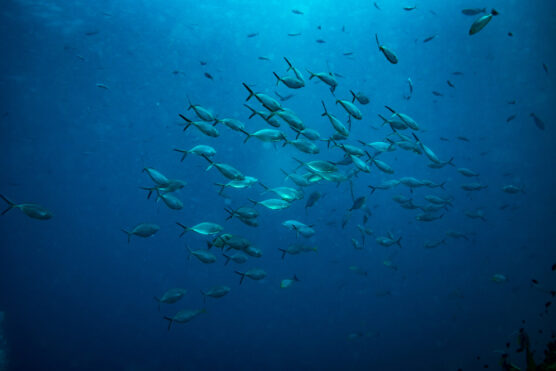
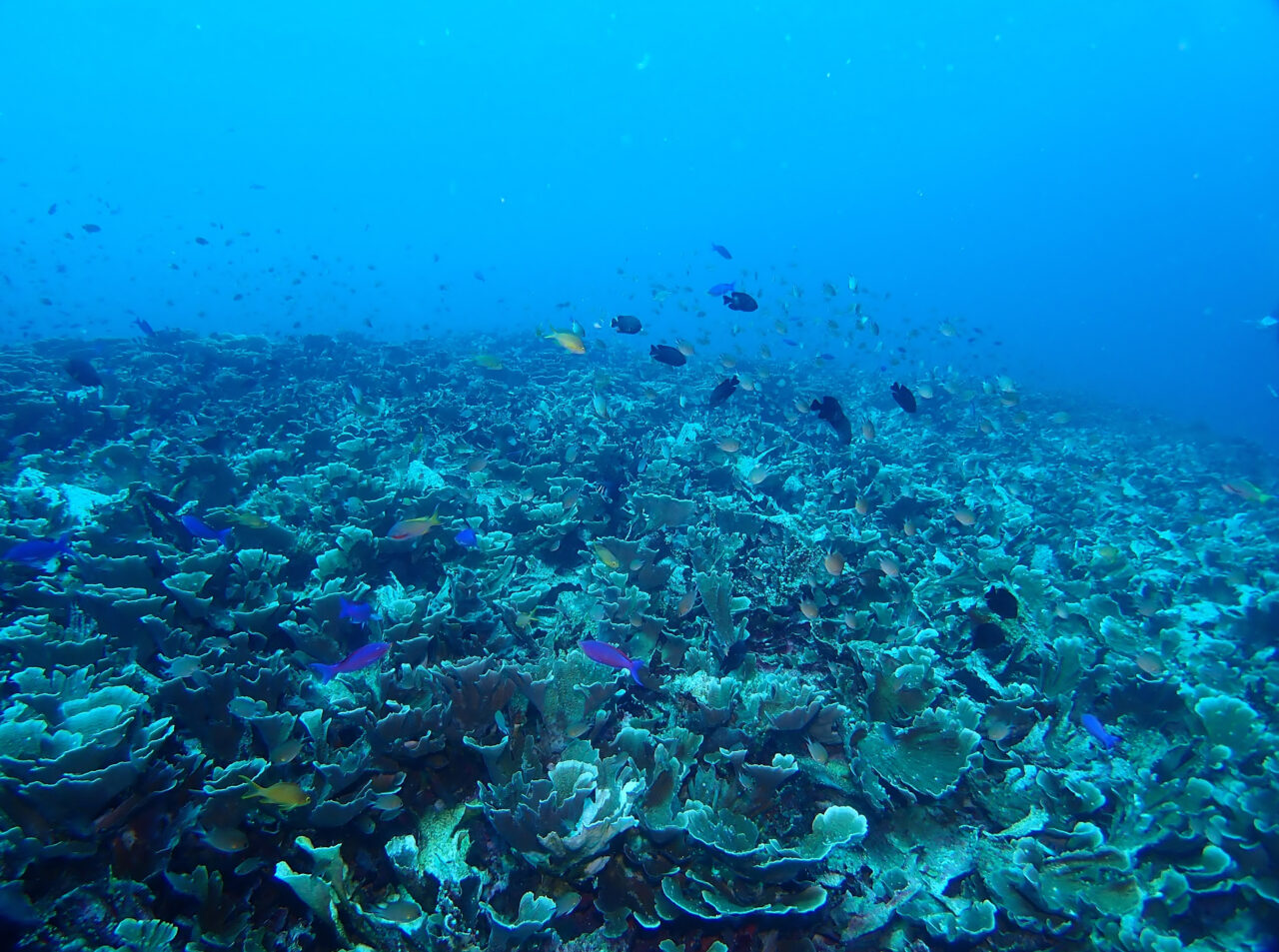
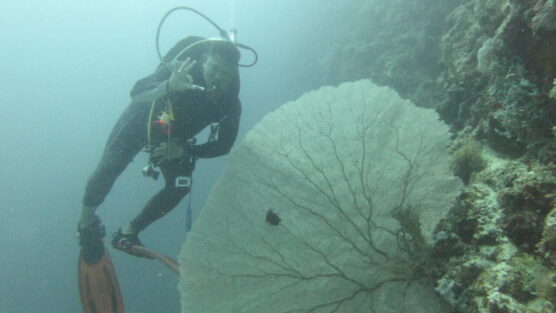
Upon the next day; I met with my Mark – my dive guide from Sea Pearl Divers and a couple of other travelers who’d been diving there also.
It was in fact the week of the annual Folk Healing Festival for which all of the island’s witches, witch-doctors, doctor-witches, shamans, warlocks, sight-seers and wizards come together to perform all manner of rituals, readings and magical things like that.
The event was held up at Mount Bandilaan where I’d climbed the observation tower; whereas a few days ago the roads up here had been all but isolated now they were swarming with people.
There were a great many stands and stalls that had been set up as the flocks of people slowly ambled from place to place, buying trinkets, receiving cleansings, taking guidance and purging themselves of illnesses.
Very nice indeed; although there were scooters and phones and a couple of speakers, the overall vibe and feel of the event felt authentic and like it really hadn’t changed much at all in a very long time.
Being a local, Mark knew of the best of the best shamans to visit and he took us to meet him. The shaman must have been in his 80’s if he was a day; his skin was gnarled like an old tree’s but still his eyes shone with energy and he moved with strength and purpose; a colourful hat with shiny pieces of metal crowning his old head.
I was third in line of our group of four and what ensued next was a most curious affair. Because the shaman did not…or would not (!) speak english, everything he said was translated for me by Mark.
First, he saw one of the girls who sat before him on the wooden chair as his hands hovered over her, feeling the invisible aura around her body. He pushed, poked and prodded then a great gurgling belch flew out of his mouth. “That’s the dark energy traveling out of her – into him – then out of him” Whispered Mark in a hushed awe.
This happened many more times over the next five minutes as sounds like “burraakkrrkkkk” and “gurrrppppp” filled the air until satisfied with his fine work the Shaman stepped back and spoke a stream of Visayan. “He is telling the girl that she has some toxic energy in her body and needs to cleanse herself with a more healthy diet, sleep and not drinking ice water”.
Next it was Mark’s turn and the process repeated; the shaman moved his hands around Mark , never touching him but appearing to touch or interact with something around him; belching and burping in a most serious manner before declaring that Mark was eating too many fatty foods which was affecting his bowel movements.
Delighted, Mark sprung up “I have been having difficult bowel movements these last few weeks”! He exclaimed with a delighted beam. “I will eat less fatty foods for sure”!
Next, it was my turn. Strangely, for some reason beyond me, I was the only person for whom the shaman didn’t burp once from my aura; this was highly disappointing for me and I almost thought of not making a donation at the end of the reading, I decided to anyway.
Anywhome; after giving my aura a (I thought somewhat ginger) prod the shaman explained that there was something up with my left lung. Only a single herb could cure it but the Shaman didn’t have any on him right now, he could find it on the hillsides in two days but I was leaving tomorrow, so my lung would have to go on being that way.
Lastly; it was the other travellers in our group. As she sat on the chair and he began to feel her aura; the Shaman’s expression suddenly changed and his tone grew much more serious and darker. A truly evil sounding belch escaped him, like the burp of the devil; his eyes rolling up into his skull as it came out.
Then he began to speak gravely. Mark translated. “He says she is being pursued by a demon born of past traumas. He says it grows closer to her by the day and she can only escape it by learning to let go of the past. In the meantime she must visit church and light a candle every day”. WOW! That was heavy!! In hindsight the rest of us all got off pretty lightly.
With that it was time to leave. We rode back down the hill and made for Mark’s house where a most mighty feast of rice and bangus and beer was prepared and we all had a jolly old party that somehow ended up by the beach several miles away.
It was a good thing to do for my last evening in Siquijor so I proceeded to get roaring drunk with everyone and the night blurs out from there!!
And so concluded my Siquijor adventure. All that remains now is for you to journey there yourself! Check out my Post: Best Places to Stay in Siquijor for Divers and Support Diving Squad when you make a reservation through one of the links on that page. Gracias!
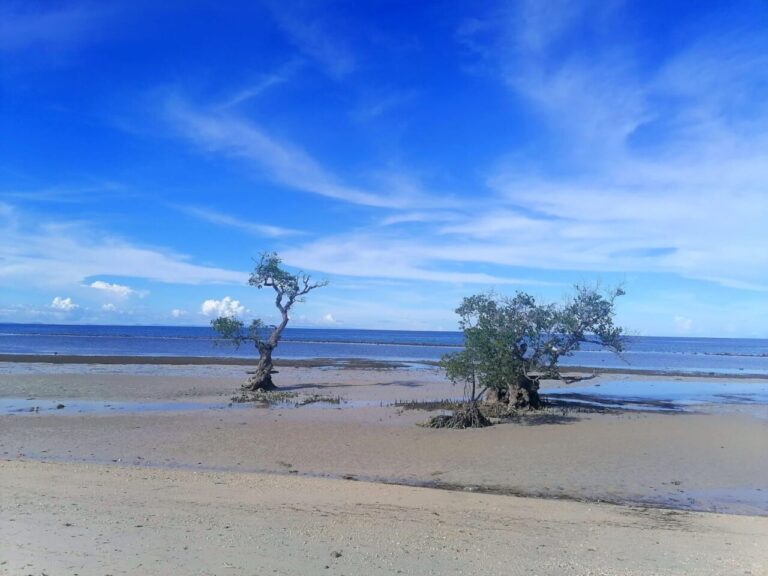
Stay Fit at Siquijor- GYMS
Staying strong on the road is important!
You never know when artificial intelligence might exceed that of it’s human creators and rise up against us…transforming this entire world into a hellish battlefield, in which man is pitted against machine…
….and then the machines start sending themselves back in time to terminate humanities leaders before they can form the future-resistance!!!
If you’ve spent all of your trip lazing around on the beach, drinking beer and stuffing your face with fried food whilst never once breaking a sweat, you’ll be the first to go, most likely converted into liquid fuel to charge the hellish machines crusade against the remnants of humanity.
But take heart…it doesn’t have to be this way…there’s a couple of gyms at Siquijor.
I went to Jorlwen fitness gym – downstairs is a little bit crowded, I can’t see how more than five or six people could workout there at a time but at least when I went it was quiet. Take some 1 peso coins as these are what you have to pay with per cup of water for the water machine (of water).
There’s also a much more spacious upstairs area, although it doesn’t have as much weights, equipment or machines. It’s more of a cardio zone. That said, there’s still enough kettlebells and matts to make do for some weights training if you get creative.
Where to Eat
There’s a whole bunch of places to eat in Siquijor. Whilst most are situated around San Juan, a few are a little more out of the way and these offer the most kickass views. Here’s 3 of my favourites:
- Marco Polo: Situated on the main strip of San Juan, close to the dive centres they serve excellent pasta and pizza with an awesome ocean view. I kept coming back here again and again.
- Overlook Restaurant and Bar: Some 15km away from San Juan, this is an awesome place to catch an ocean sunset with plenty of tasty and reasonably priced filipino food.
- MYN Sunset View Bar and Grill: Also a bit of a mission from San Juan but worth it for the incredible views of not just the sunset but much of the island and its mountains. Really spectacular and loads of western and filipino food to choose from.
Siquijor Nightlife
Siquijor isn’t really a party-party place, in fact less its much less so than most of the rest of the Philippines. People really go here to get away from all that and be immersed in nature. Also the locals are more conservative than other parts of the Philippines… However, there’s still a few cool bars you can go to.
- Baha Bar for decent live music, tasty food and lethal cocktails. Still not quite a party place though.
- Prime Bar and Nightclub: One of Siquijors few nightclubs, it stays open till, like, 4am, brah.
- Why Not: Another one of the few nightclubs , stays open until 3am brahhh.
Siquijor FAQ
Absa-freaking-loutley. Many people get scuba certified at Siquijor. Virtually all of the dive sites are beginner friendly with no currents and shallow waters.
Cheap! With Sea Pearl divers, it cost me just under 10,000 PHP for 7 dives (I had my own gear). Siquijor is actually one of the cheapest places to dive in the Philippines.
Some of the most popular dive sites include: “The Wall” which offers a spectacular stretch of reef, “The Cave” for the chance to see whitetip reef sharks, “Coral Gardens” for superb reef and plenty of macro critters and “Sunken Island” for an exciting drift dive with schooling milk fish,
So much awesome stuff! An endless variety of macro critters including many types of nudibranch and crustaceans as well as slightly larger animals like frogfish, mantis shrimp and reef fish… and still bigger creatures like turtles and schooling milk fish as well as the occasional whitetip reef shark. On very rare occasions hammerhead sharks and whale sharks have been sighted.
Totally little dude! You can easily get there via a ferry from nearby islands or even fly into Siquijor airport from Cebu. No fuss, no worries! Use This Link to check out Ferry Schedules to Siquijor!
There’s many waterfalls with swing jumps, a 1km deep cave, a 10m ocean cliff jump, mystical healing, an epic panoramic viewpoint from the top of the island and even skydiving. Far out!
We’re glad you asked! Check out our main page on Siquijor Accommodation for Scuba Divers!
Siquijor Diving Squad DEBRIEFING:
Dudddde – you like – totally just finished the Diving Squad dive guide on diving Siquijor for divers! Bloody good job!!
We’ve covered an absolute ton. Let’s quickly recap: First we went over What you can See Diving Siquijor, accompanied by original photos and videos from my time there in March 2013.
Then we went over the Best Siquijor Dive Sites, followed by Where to Stay for Divers and Choosing a Dive Centre if the place you’re at doesn’t have one.
After that we covered Diving Season, preceded by Other Things To Do, and then Getting There.
After this I gave you a hearty recount of My Experience Diving & Travelling Siquijor.
Following that big ol’ mouthful I talked about Local Gyms and then discussed some of the coolest Places to Eat, the sparse Nightlife and finally rounded it all off with a tasty FAQ Section (classic!).
Finally we’ve finished the article and you’re in real time, reading this here conclusion. All that remains now is for you to go ahead and book your dream trip to Siquijor!
Now, when you do book your accommodation or ferry ride through one of the affiliate links on this site, we’ll get a small, yet deliciously nutritious affiliate commission at no extra cost to yourself.
Awesome! It’s stuff like that which helps us keep Diving Squad as the best damn scuba blog in the multi-verse whilst continuing to fling our members out into far-flung corners of the world to gather fresh new content for you. Thanks!!
Plus, it’s always cheaper to book in advance than it is to pay when you get there – so just like at kindergarten everybody’s a winner – hooray!!! For now – peace out.
Check out Similar Content:
